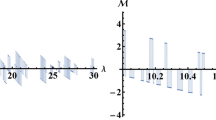Summary
The effects of internal microstress fields are neglected in a usual simulation of the diffusion of a small solute trough solid heterogeneous media. However, when a heterogeneous material is used in a structure undergoing external mechanical loading, highly nonuniform stress fields can arise locally due to the variable microstructure. In this paper a simple quasi-Fickian model is studied which employs a spatially variable stress-dependent diffusivity,D σ. The structure ofD σ stems from an assumption that the stresses nonuniformly open and close the pores of the material microstructure, thus providing preferential sites for accumulation of the diffusing solute. When σ=0, the usual stress-free Fickian diffusivity,D 0, is recovered. Because of the highly oscillatory stress fields on the micro level, when employing numerical methods, such as the finite element or finite difference method, the distance between discretization nodes must be far smaller than the microstructural oscillations to obtain accurate simulations. This fact makes direct numerical simulations involvingD σ virtually impossible without computationally intensive, and complicated, special techniques. In this paper upper bounds are developed for the difference between solutions produced when usingD σ and alternativelyD 0 in the body under analysis. The general case, whenD 0, σ and consequentlyD σ, are spatially variable, is considered. The bounds are a function of onlyD 0 and σand do not require any knowledge of the stress-dependent solution, and can thus be used as an a-priori check to determine whether potentially expensive computations are necessary.
Similar content being viewed by others
References
Gerberich, W. W., Livne, T., Chen, X. F., Kaczorowski, M.: Crack growth from hydrogen-temperature and microstructural effects in 4340 steel. Metall. Trans.19A, 1319–1334 (1988).
Gerberich, W. W., Foecke, T. J.: Hydrogen enhanced decohesion in Fe−Si single crystal. In: Implications to modeling thresholds in hydrogen effects on material behavior (Moody, N. R., Thompson, A. W., eds.), pp. 687–702. The Minerals, Metals and Materials Society 1990.
Van der Burg, M. W. D., Van der Giessen, E., Brouwer, R. C.: Investigation of hydrogen attack in 2.25Cr-1Mo steels with a high-triaxiality void growth model. Acta Metall.44, 505–518 (1996).
Metals Handbook (Leiter, R. et al. eds.). Failure analysis and prevention, vol. 2, 8th ed., Ohio: The American Society for Metals 1975.
Maxwell, J. C.: On the dynamical theory of gases. Philo. Trans. Soc. London157, 49 (1867).
Joseph, D. D., Preziosi, L.: Heat waves. Rev. Mod. Phys.61, (1) 41–73 (1989).
Jou, D., Casas-Vazqzez, J., Lebon, G.: Extended irreversible thermodynamics. Rep. Prog. Phys.51, 1105–1179 (1988).
Dreyer, W., Struchtrup, H.: Heat pulse experiments revisited. Cont. Mech. Thermodyn.5, 3–50 (1993).
Chandrasekhariah, D. S.: Thermoelasticity with second sound: a review. Appl. Mech. Rev.39, 355–376 (1986).
Muller, I., Ruggeri, T.: Extended thermodynamics, New York: Springer 1993.
Crank, J.: The mathematics of diffusion, 2nd ed., Oxford: Oxford Science Publications 1975.
Aifantis, D. C.: New interpretation of diffusion in regions with high diffusivity paths: A continuum approach. Acta Metall.27, 683–691 (1979).
Doig, P., Jones, T. A.: Model for the initiation of hydrogen embrittlement cracking at notches in gaseous hydrogen environments. Metall. Trans.18A, 1993–1998 (1977).
Unger, D. J., Aifantis, D. C.: On the theory of stress-assisted diffusion, part II. Acta Mech.47, 117–151 (1983).
Unger, D. J., Gerberich, W. W., Aifantis, D. C.: Further remarks on the implications of steady-state stress-assisted diffusion on environmental cracking. Scripta Metall.16, 1059–1064 (1982).
Van Leeuwen, H. P.: A quantitative model of hydrogen induced grain boundary cracking. Corrosion29, 197–204 (1973).
Hashin, Z.: Analysis of composite materials: a survey. J. Appl. Mech.50, 481–505 (1983).
Aifantis, E. C.: Some remarks concerning the solid-state diffusivity tensor. In: Proceedings of the Sixth Canadian Congress of Applied Mechanics, pp. 957–958. Vancouver: University of British Columbia Press 1977.
Flynn, C. P.: Point defects and diffusion. Oxford: Clarendon Press 1972.
Voigt, W.: Über die Beziehung zwischen den beiden Elastizitätskonstanten isotroper Körper. Wied. Ann.38, 573–587 (1889).
Reuss, A.: Berechnung der Fließgrenze von Mischkristallen auf Grund der Plastizitätsbedingung für Einkristalle. ZAMM9, 49–58 (1929).
Hill, R.: The elastic behaviour of a crystalline aggregate. Proc. Phys. Soc. LondonA65, 349–354 (1952).
Author information
Authors and Affiliations
Additional information
Dedicated to Prof. Dr. Peter Haupt on the occasion of his 60th birthday
Rights and permissions
About this article
Cite this article
Zohdi, T.I., Wriggers, P. On the effects of microstress on macroscopic diffusion processes. Acta Mechanica 136, 91–107 (1999). https://doi.org/10.1007/BF01292300
Received:
Revised:
Issue Date:
DOI: https://doi.org/10.1007/BF01292300




